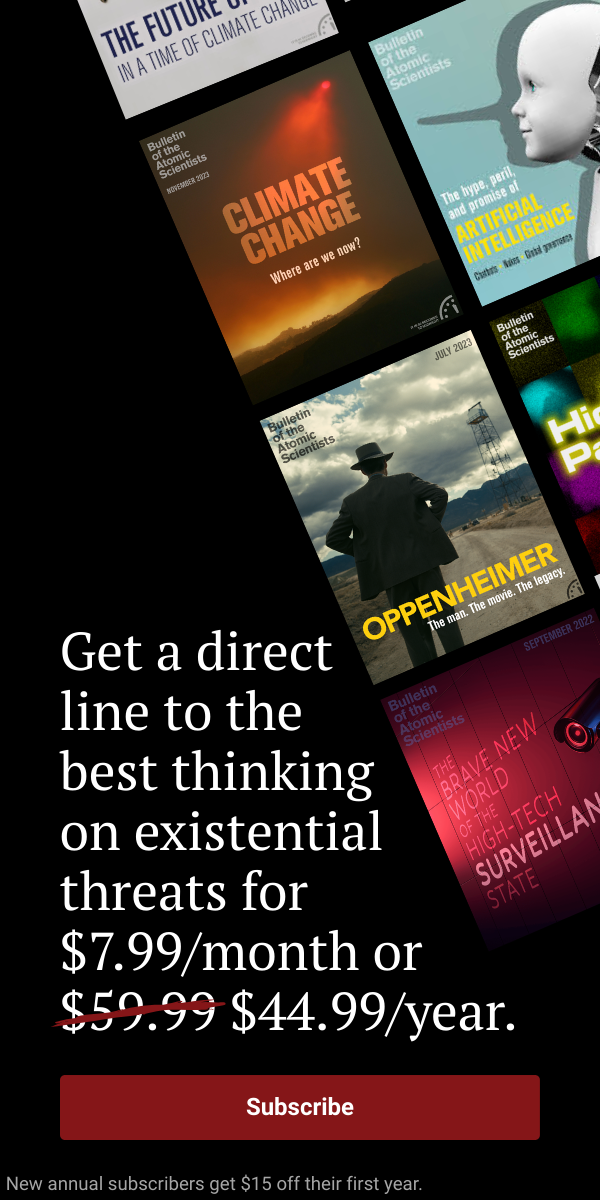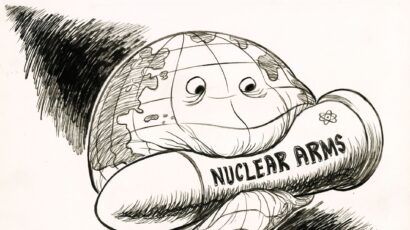In a casual, often-irreverent tone, journalist William Langewiesche walked readers of the December 2006 issue of The Atlantic through the possibilities and hurdles associated with procuring the required material for a nuclear weapon, transporting it to a safe place, and assembling the bomb. With no ambitions to provide solutions to these questions, his article was a pretext to draw attention to the successes and failures of U.S. assistance to Russia and other former Soviet states in protecting fissile material, safeguarding borders, identifying trafficking routes, and exposing the involvement of local criminal groups.
Langewiesche diverges from the conventional wisdom: The odds of terrorist success are very slim, he concludes. Yet he, like many other journalists and researchers, makes two assumptions that neglect important qualifying factors that would improve our understanding of a state’s or terrorist group’s capability to acquire nuclear weapons or dirty bombs.
The first and most common assumption is that procuring material and equipment is the largest obstacle. Most reports fall prey to the simplistic notion that globalization and the internet have made scientific knowledge virtually universal: Once the material is in hand, states or terrorist groups are merely a few steps away from their goal.
Specialized know-how, however, is difficult to come by. Knowledge can be divided generally into two categories: explicit knowledge (information or instructions that can be formulated in words, symbols, formulas, or diagrams and can be easily transferred) and tacit knowledge (unarticulated, personally held knowledge or skills that a scientist or technician acquires and transfers through a practical, hands-on process and direct interactions with other scientists).
Explicit information such as designs and instructions cannot be efficiently used in the absence of the related tacit knowledge. Science and technology scholars have demonstrated that it took Manhattan Project scientists with explicit knowledge of physics and possession of fissile material considerable time to design and construct a workable and reliable prototype implosion nuclear weapon. First they needed to solve a multitude of difficult engineering and interdisciplinary scientific problems, which required hiring thousands of technical specialists to develop a unique knowledge base and building an extensive, indigenous infrastructure.
The novelty of nuclear technology was not the sole challenge. Soviet scientists encountered significant problems replicating the U.S. design and production process obtained from Soviet spy Klaus Fuchs, even though they already had an active nuclear program with knowledgeable scientists and engineers. The British encountered similar problems, even though their scientists contributed to the Manhattan Project. Each country’s program had the character of an independent invention.
More recently, bioweapons research illustrated the critical role that specialized know-how plays in transferring existing technologies to a new environment. It took Soviet scientists at the Stepnogorsk bioweapons production plant about five years to design and produce a weaponizable strain of anthrax in in the late 1980s despite about 400 pages of protocols describing the development and production of earlier Soviet anthrax weapons, samples of an anthrax strain developed at the Kirov bioweapons facility, and the transfer of 65 senior bioweaponeers from other weapons sites.
The focus on material leads to a second widespread assumption: the existence of a nuclear black market in the former Soviet Union. After the Soviet Union’s dissolution, former member states inherited an enormous amount of nuclear and radioactive material, which has been the source of a number of trafficking incidents. Revelations about the nuclear network of Pakistani scientist A. Q. Khan only reinforced trepidations of a burgeoning black market in the region, adding concerns that organized crime might coalesce with this market to channel nuclear material to terrorists.
Before concluding anything about the nature of a nuclear black market in the former Soviet Union, it is useful to consider the qualities of markets in general. At the very least, a market consists of a transaction between a supplier and a client and the transportation and financial mechanisms that allow goods and funds to circulate. The Khan network possessed these features. With an established clientele, a network of suppliers, transport and funding mechanisms that evaded scrutiny, and direct contacts between Khan or his suppliers and their clients, the network provided a flexible list of equipment and expert services that clients could choose from.
The supposed nuclear black market in the former Soviet Union lacks an important component of any market: an established clientele. According to the James Martin Center for Nonproliferation Studies’s Illicit Trafficking Database and publications, most nuclear transactions are conducted by isolated suppliers–primarily economic opportunists–who have no clients at the outset, and blindly probe the underground world to identify potential buyers. An analysis of 183 cases that occurred between 2001 and 2006 in the former Soviet Union also showed that traffickers transport their goods along various routes–an east-west route from Russia, Ukraine, and Belarus to Europe; a southwest corridor crossing Central Asia and the Caucasus toward Europe; and a southeast corridor, from Central Asia to neighboring Asian and Mideast countries–presuming the existence of a demand in countries along the way. These smugglers are usually intercepted before reaching their declared destination, caught while transporting the goods, crossing a border, or during the sale of the material (often to an undercover agent).
Additionally, the vast majority of materials involved in documented trafficking transactions have no application in a nuclear weapon or dirty bomb, and their value is typically overestimated. Fifty percent of trafficking incidents between 2001 and 2006 concerned radioactive orphan sources, contaminated scrap metal, and radioactive isotopes. Accounts of these incidents rarely indicate the exact quantity or quality of the radioactive material, making it difficult to evaluate the significance of the incident; the analysis of these cases showed, however, that most of them involve industrial instruments that typically contain small quantities of radioactive material. Among the 10 reported incidents involving highly enriched uranium (HEU), only 3 involved weapon-grade material enriched to 80 percent or more. And in these cases, the total material amounted to gram-quantities (5 grams, 170 grams, and 100 grams), hardly enough material for a weapon, which requires at least 10 to 15 kilograms of HEU.
The data-set shows no clear nexus between trafficking, organized crime, and terrorism. Three incidents have involved undocumented connections with terrorist organizations, and 12 cases have a crime-group connection. These cases, however, display the same amateurish features as the rest of the data-set, and involve small quantities of material–such as Osmium 187, low enriched uranium, and depleted uranium–that have no weapons or dirty bomb application. Only one incident involved both weapon-grade HEU and a crime connection.
With these examples, one can see how focusing on access to materials dangerously mischaracterizes the challenges that terrorists and states face in pursuing nuclear weapons. The general emphasis on explicit scientific knowledge, rather than the highly specialized know-how derived from extensive hands-on experience is similarly misleading. While focusing on vulnerability-based analyses of the nuclear threat, the true capabilities of terrorists or states are overlooked.
Together, we make the world safer.
The Bulletin elevates expert voices above the noise. But as an independent nonprofit organization, our operations depend on the support of readers like you. Help us continue to deliver quality journalism that holds leaders accountable. Your support of our work at any level is important. In return, we promise our coverage will be understandable, influential, vigilant, solution-oriented, and fair-minded. Together we can make a difference.
Topics: Nuclear Weapons, Opinion















